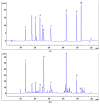Quality Assessment of Artemisia rupestris L. Using Quantitative Analysis of Multi-Components by Single Marker and Fingerprint Analysis
- PMID: 35565985
- PMCID: PMC9099709
- DOI: 10.3390/molecules27092634
Quality Assessment of Artemisia rupestris L. Using Quantitative Analysis of Multi-Components by Single Marker and Fingerprint Analysis
Abstract
The chromatographic fingerprint of 14 batches of Artemisia rupestris L. samples were established in this study. The constituents of ten components in Artemisia rupestris L. were determined using quantitative analysis of multi-components by single marker (QAMS) and the external standard method (ESM). Due to their stability and accessibility, chlorogenic acid and linarin were used as references to calculate the relative correction factors (RCFs) of apigenin-C-6,8-pentoside-hexoside, apigenin-C-6,8-di-pentoside, luteolin, 3,4-dicaffeoylquinic acid, 3,5-dicaffeoylquinic acid, 4,5-dicaffeoylquinic acid, chrysosplenetin B, and sbsinthin, based on high-performance liquid chromatography (HPLC). The value calculated by QAMS was consistent with that of the ESM, and the reproducibility of RCFs was found to be reliable. In conclusion, simultaneous determination of the ten components by the QAMS method and chromatographic fingerprint analysis were feasible and accurate in evaluating the quality of Artemisia rupestris L. and can be used as reference in traditional Chinese medicine quality control.
Keywords: Artemisia rupestris L.; fingerprint analysis; high-performance liquid chromatography; quality control; quantitative analysis of multi-components by single marker.
Conflict of interest statement
The authors declare no conflict of interest.
Figures


Similar articles
-
[Quality control method for phenolic acid components in abandoned stems and leaves of Artemisia selengensis based on UPLC fingerprint combined with quantitative analysis of multi-components by single marker (QAMS)].Zhongguo Zhong Yao Za Zhi. 2024 Jul;49(13):3566-3573. doi: 10.19540/j.cnki.cjcmm.20240405.204. Zhongguo Zhong Yao Za Zhi. 2024. PMID: 39041128 Chinese.
-
Quality Assessment of Corydalis saxicola Bunting Using Quantitative Analysis of Multi-Components by Single Marker and Fingerprint Analysis.J Sep Sci. 2024 Nov;47(22):e70028. doi: 10.1002/jssc.70028. J Sep Sci. 2024. PMID: 39540876
-
[Chemical pattern recognition of Atractylodes chinensis from different producing areas and establishment of quantitative analysis of multi-components by single marker (QAMS) method for four components].Zhongguo Zhong Yao Za Zhi. 2022 Aug;47(16):4395-4402. doi: 10.19540/j.cnki.cjcmm.20211217.201. Zhongguo Zhong Yao Za Zhi. 2022. PMID: 36046868 Chinese.
-
[Study on quality control of Houttuynia Cordata, a traditional Chinese medicine by fingerprint combined with quantitative analysis of multi-components by single marker].Zhongguo Zhong Yao Za Zhi. 2013 Aug;38(16):2682-9. Zhongguo Zhong Yao Za Zhi. 2013. PMID: 24228587 Chinese.
-
[Content determination of five flavonoids in Tibetan medicine Rhododendron anthopogonoides by quantitative analysis of multi-components by single marker (QAMS)].Zhongguo Zhong Yao Za Zhi. 2021 May;46(9):2229-2236. doi: 10.19540/j.cnki.cjcmm.20210129.302. Zhongguo Zhong Yao Za Zhi. 2021. PMID: 34047125 Chinese.
Cited by
-
Luteolin 7-Glucuronide in Artemisia rupestris L. Extract Attenuates Pulmonary Fibrosis by Inhibiting Fibroblast Activation and FMT via Targeting of TGF-β1.Antioxidants (Basel). 2025 Apr 29;14(5):533. doi: 10.3390/antiox14050533. Antioxidants (Basel). 2025. PMID: 40427415 Free PMC article.
-
Quantitative analysis of multi-components by single marker method combined with UPLC-PAD fingerprint analysis based on saikosaponin for discrimination of Bupleuri Radix according to geographical origin.Front Chem. 2024 Jan 19;11:1309965. doi: 10.3389/fchem.2023.1309965. eCollection 2023. Front Chem. 2024. PMID: 38313222 Free PMC article.
-
Unveiling the anticancer potential of flavonoids in hepatocellular carcinoma through microbiome and spatially resolved metabolomics analysis.Discov Oncol. 2025 Jul 14;16(1):1327. doi: 10.1007/s12672-025-03159-x. Discov Oncol. 2025. PMID: 40658186 Free PMC article.
-
Progress and prediction of multicomponent quantification in complex systems with practical LC-UV methods.J Pharm Anal. 2023 Feb;13(2):142-155. doi: 10.1016/j.jpha.2022.11.011. Epub 2022 Dec 5. J Pharm Anal. 2023. PMID: 36908853 Free PMC article. Review.
References
-
- Liu Y.M., Liu W.X., Yikemu Y.W.T. Pharmacography of Uighur. Xinjiang People’s Publishing House; Urumqi, China: 1985. pp. 1–5.
-
- Nayak M.K., Daglish G.J., Byrne V.S. Effectiveness of Spinosad as a grain protectant against resistant beetle and psocid pests of stored grain in Australia. J. Stored Prod. Res. 2005;41:455–467. doi: 10.1016/j.jspr.2004.07.002. - DOI
-
- Liu Y.M., Yu D.Q. Studies on chemical constituents in herb from Artemisia rupestris. Acta Pharm. Sin. 1985;20:514–518.
-
- Xu G.S., Chen X.Y., Yu D.Q. Rupestonic acid, a new sesquiterpene from Artemisia rupestris L. Acta Pharm. Sin. 1988;23:122–125.
-
- Song W.X., Ji T.F., Si Y.K., Su Y.L. Studies on chemical constituents in herb from Artemisia rupestris. Chin. J. Chin. Mater. Med. 2006;31:1790–1792.
MeSH terms
Substances
Grants and funding
LinkOut - more resources
Full Text Sources

